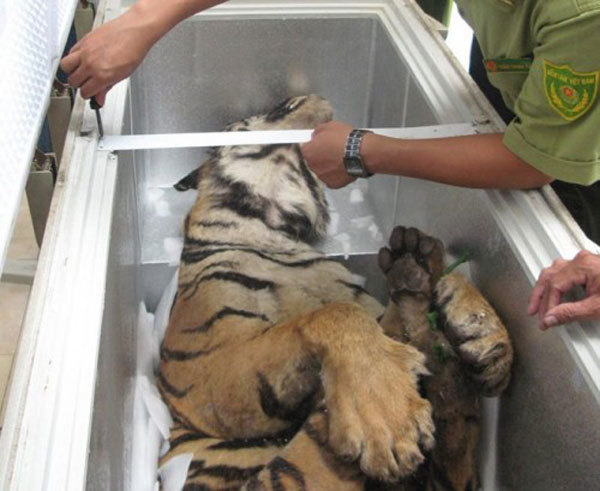“Buying a tiger is as easy as buying a refrigerator,” Vu Ngoc Thanh, lecturer at the University of Natural Sciences, a member school of the HCMC National University, said.

Thanh said a state official who bought a stuffed tiger m asked to change the product three times until he was satisfied.
The International Union for Conservation of Nature (IUCN) estimates that only five tigers exist in the wild in Vietnam.
Tigers have disappeared from nearly all areas and their habitat area in the world has reduced to 6 percent. It is estimated that there are only 3, 200 tigers living in the wild.
| Tigers have disappeared from nearly all areas and their habitat area in the world has reduced to 6 percent. It is estimated that there are only 3, 200 tigers living in the wild. |
The last sighting of Indochina tigers in Vietnam, which also live in Myanmar, Thailand, Laos, Cambodia and southwest of China, was in 1997, thanks to camera traps.
Facing the risk of extinction, the species is classified by IUCN as critically endangered (CR). Losing habitat and natural food sources and being hunted intensely are dangers for them.
“In the forests of Indochina triangle, one thousand traps can be found a day,” Thanh said. “One can be paid 0.1 tael of gold if he just finds one footprint of tigers. ”
Unlike lions who live in groups, tigers live alone. After the pregnancy period, mother tigers will give birth to 2-3 cubs. Newborn tiger cubs with weak and closed eyes that cannot move will be nurtured by the mother tiger for two years until they are mature and can live independently.
Tigers are respected in Asian cultures, which explains India's success in tiger conservation. In Thailand, China, Laos and Vietnam, however, tigers are exploited. In these countries, captive tigers are used for their valuable body parts and entertainment purposes.
A member of an NGO in Vietnam related a story about how the organization rescued a female tiger some years ago. After the tiger recovered, it was brought to a national park in Dong Nai province, where they discovered the footprint of another tiger which visited the female tiger a couple of weeks later.
However, the female tiger was then taken to a private zoo on the island where it died some months later.
A survey conducted by Traffic in 2017 found that in Hanoi and HCMC, six out of every 100 surveyed people once sought to purchase or use products made of tigers’ organs, and 83 percent of them had used tiger bone glue.
Linh Ha

Experts discuss ways to protect tigers
Experts discussed Vietnam’s efforts to protect tigers and other endangered animals at a forum yesterday.

Experts point to tiger keeping failings
A recent tiger attack in Binh Duong Province has raised questions over regulations and criteria for tiger keeping in the area.
 “Buying a tiger is as easy as buying a refrigerator,” Vu Ngoc Thanh, lecturer at the University of Natural Sciences, a member school of the HCMC National University, said.
“Buying a tiger is as easy as buying a refrigerator,” Vu Ngoc Thanh, lecturer at the University of Natural Sciences, a member school of the HCMC National University, said.